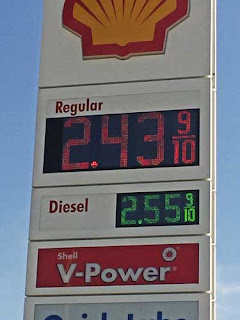 |
| Gas station prices, April 2017 (photo by Vicki) |
Forgive me. Welcome back. Retail pricing is one of my pet peeves. (Surprise! I have lots of those.)
When I was about 10, I asked my father, who owned a retail store, why prices ended in 99 cents or 98 cents or 95 cents. Why didn’t he charge an even dollar? I don’t remember his answer, but it couldn’t have been very convincing as I’m still wondering. I finally decided to dig a little.
It’s Not New
Nowadays, pricing items slightly below the whole number goes by different names, most often psychological pricing or charm pricing.
Business historians haven’t been able to pin down when the practice began, though advertisements applying the strategy have been around since at least the late 1800s.
 |
| Macy ad from 1880s (from www.nytimes.com/2009/02/08/weekinreview/08arango.html?) |
 |
| Ad for tombstone, Sears Roebuck & Co. catalog #110, 1900. |
As any business or marketing major can probably tell you, pricing strategies are one of many ways to increase sales. That pricing items slightly below the next whole dollar works is supported by numerous studies. The most commonly proposed explanation is that consumers read from the left and tend to drop off or pay less attention to the rightmost digits.
Researchers from Union College and Rutgers University provided direct evidence for this explanation in a 2005 study. In different trials, the researchers had 122 test participants estimate how many items of different prices could be purchased for $73. The participants thought they could buy significantly more items priced with 99-cent endings than items with comparable 00 ending prices.
Analysis of estimation errors indicated that the participants treated a substantial proportion of items with 99-cent ending as if their costs were up to a dollar less than they actually were, thus reflecting a pattern consistent with the drop-off explanation. As expected, increased motivation to come up with better estimates moderated the effect.
Despite my focus on two-digit endings, prices with a single 9 ending are common and highly effective as was shown, for example, in a 2003 study by researchers from the University of Chicago and MIT. In one of their three field experiments to test the 9 ending, they priced a women’s clothing item at $34, $39 and $44. The item sold best at $39.
Wrap Up
Psychological pricing has been inescapable for so many years, why should it bother me? Mostly, I suppose, because I feel the vendor is treating me like a fool. I do that well enough on my own, without the help of the price of salami ($5.99/lb).
 |
| Part of a supermarket circular, April 2017. |
Anyway, as my pet peeves go, this one isn’t as bad as people saying no problem instead of you’re welcome, which I addressed in an earlier post, Linguistic Longings. But I do wish we could make it go away. I’d ask you to join me in a boycott, except there would be nowhere to shop. Oh well, thanks for stopping by.
P.S.
Example reading on psychological pricing:
en.wikipedia.org/wiki/Psychological_pricing
www.livescience.com/33045-why-do-most-prices-end-in-99-cents-.html
marketing-bulletin.massey.ac.nz/V8/MB_V8_N1_Holdershaw.pdf
www.amazon.com/Priceless-Myth-Fair-Value-Advantage/dp/0809078813
Union College and Rutgers University study in Psychology and Marketing journal: onlinelibrary.wiley.com/doi/10.1002/mar.20084/abstract
University of Chicago and MIT study in Quantitative Marketing and Economics journal: link.springer.com/article/10.1023%2FA%3A1023581927405

No comments:
Post a Comment